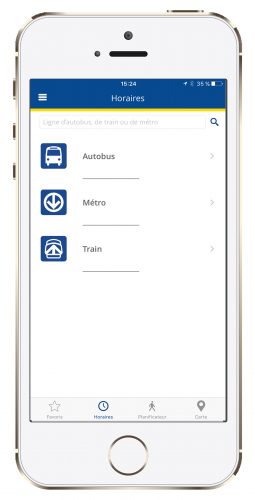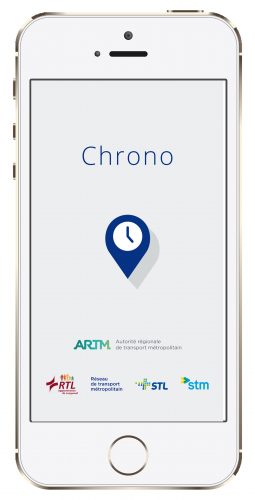How mobile technology connects Montréal’s transport network
- Like
- Digg
- Del
- Tumblr
- VKontakte
- Buffer
- Love This
- Odnoklassniki
- Meneame
- Blogger
- Amazon
- Yahoo Mail
- Gmail
- AOL
- Newsvine
- HackerNews
- Evernote
- MySpace
- Mail.ru
- Viadeo
- Line
- Comments
- Yummly
- SMS
- Viber
- Telegram
- Subscribe
- Skype
- Facebook Messenger
- Kakao
- LiveJournal
- Yammer
- Edgar
- Fintel
- Mix
- Instapaper
- Copy Link
Posted: 7 March 2018 | Odile Thibault, Sophie Paquette - Réseau de transport métropolitain | No comments yet
Public transit users in the Montréal metropolitan area now have access to a mobile application called Chrono. Sophie Paquette – Director of STI Innovation, RTM and Odile Thibault of RTM, discuss how the app helps to provide streamlined journeys to its users with continual real-time information, whilst enabling public transport operators to become mobility managers.


The Autorité régionale de transport métropolitain (ARTM)’s app, Chrono, has incorporated features that enable users to track buses in real time and receive notifications of any possible delays. In Montréal the climate is harsh and the winter long, making continuous information on public transport services a necessity in improving passengers’ lives.
Chrono: the time-saving app
Chrono’s intuitive interface relies on advanced technology to process a mass of information in real time and feed data to the application.
The app updates the position of vehicles every 10-15 seconds so that customers can see the location of transit vehicles and plan their trip accordingly.
If their devices are connected to a wireless network (like Wi-Fi, 3G or 4G), customers can also track the position of the Société de transport de Laval (STL)’s buses in real time. Currently, only RTM commuter trains and buses from the Laurentides sector, in beta version, can be tracked but during early 2018, all RTM, RTL and Société de transport de Montréal (STM) real-time bus positions will be added. In the future, Chrono will cover all services across the metropolitan area.
Once a user account is created within the app, additional features become available. The user can add their favourite modes (buses, metro and trains), routes or stops, they can view the next arrival times at their usual stops when the app opens, and, when the data is available, alerts can be customised for service statuses on their favourite routes.
Relying on open data from every operator in the region, the Chrono app can be used to check bus, metro and commuter train schedules even when offline. It can also be used to locate bus stops, metro stations and train stations across the territory and has a trip-planning tool that enables users to determine the best intermodal travel route.
Available free of charge for smartphones running the iOS or Android operating systems, the new Chrono app replaced the former Agence métropolitaine de transport (AMT) Chrono app in August 2017, which at the time only provided information about commuter train services.
Timeline of constructive partnerships


The latest version of Chrono was developed after the restructuring of the governance model for shared transportation in the Montréal metropolitan area
At the end of 2013, the AMT, which then managed the commuter train service in the Montréal metropolitan area, launched its first version of the AMT Chrono mobile app. It made a real difference for their customers at the time, but since many people use more than one mode of public transport, it was merely the beginning. Three years later, the AMT concluded an initial partnership with the RTL to integrate the latter’s bus services, as the RTL had equipped its bus fleet with an operational support and customer information system, known as OSCIS, that was compatible with the AMT’s.
After the new governance model for shared transportation in the Montréal metropolitan area came into effect on 1 June 2017, the ARTM, responsible for public transit planning across the metropolitan territory, awarded RTM the contract to develop and promote the new version of the Chrono mobile app, which was successfully launched in August 2017. After only four months, the app had been downloaded more than 55,000 times – a clear sign that it meets a real need.
Under the ARTM’s mandate, the four operators provide data for their respective territories and work together to develop and improve the Chrono app.
Tangible improvements in organisational performance
Behind the Chrono mobile app is the intermodal OSCIS. This system tracks vehicles in the metropolitan area in real time to provide customers with predicted arrival times and information on service disruptions. As a result, the agencies responsible for public transport services are well equipped to optimally manage the regular daily service and any disruptions or incidents.
With 200 GPS devices installed on-board the vehicles in December 2017 – and a goal of 1,000 by December 2019 – vehicle movements are tracked to the nearest second. This 24/7 real-time monitoring rapidly identifies service deficiencies and shortens reaction times for detecting an anomaly, issuing communications and re-establishing service.
The ability to view past and real-time bus and train travel makes it easier to analyse network disruptions for an enhanced customer complaint management process and improved monitoring of supplier contract performance.
The system’s security settings give administrators granular control over its features and data. Its flexibility enables it to limit a user’s access to specific features and filter certain types of data. At the same time, this web-based solution ensures access to the app from any location, including different control centres and intermodal transportation hubs where employees in the field could be working. Transport partners can also manage operator and driver assignments more efficiently.
The system also significantly increases organisational performance. Operators have the means to complete such comprehensive analytical functions as automatically recording delays, which only requires one half-day of work per month, compared to 5.5 days previously. More than 6.6 million GPS locations are collected, analysed and stored on a daily basis, and more than 4.7 million projections are calculated daily (compared to 0.9 million in 2012) to predict individual arrival times.
In terms of planning, passenger counter data is indispensable for developing services where they are most needed. As for management, the pooling system used by the various operators helps amortise costs. Above all, however, the system is the best tool for pushing the administrative boundaries of organisations to ensure the smooth flow of information and best-in-class customer experience with a new integrated mobility approach.
The benefits for users are also particularly clear: the system can provide information to travellers on a number of platforms, via SMS, variable message signs, updated PA announcements, social media, websites and, of course, via Chrono.
OSCIS: an evolutionary system


An intermodal operational support and customer information system (OSCIS) underpins Chrono and keeps passengers updated
To feed Chrono, OSCIS relies on another entirely web-based application and uses a modular open system architecture that is flexible and capable of integrating new features. It is imperative that the technological innovation of OSCIS develops incrementally to ensure that the progressive implementation of improvements does not cause malfunctions.
This architecture must also run in high-availability mode to avoid service interruptions when computer services are disrupted. The information processing load is spread over multiple servers, the main data hosting site and the external hosting site. This makes optimal use of the infrastructure, providing increased processing capabilities and a more robust system that is capable of ensuring service continuity in the event of a problem. The open architecture also allows for easy integration with other systems in the Montréal metropolitan area, enhancing daily operations and, above all, customer experience.
The system also offers a portal, giving users access to open data feeds on schedule adherence, vehicle positions and customer alerts, in standard GTFS and GTFS-R formats. Independent companies, for example TransitApp and Google Maps, use the system to drive or develop other digital platforms.
Connected travel: simple and hassle free
Technological innovation is revolutionising travel habits by providing customers with new trip-planning possibilities. Access to real-time data allows users to plan and modify their journeys better in the event of a disruption.
People are now very much aware of the benefits that digital technology can bring to their everyday lives and mobility – being a key component – must continue to use the most reliable innovations. For this reason, as new transport information becomes available in open data, updates will be made to Chrono to ensure optimal performance.
The benefits are obvious: it provides easy access to information, reinforces a sense of comfort and security, promotes customer loyalty and encourages customers to choose more sustainable modes of transport. With new technological tools like Chrono, public transit management become true mobility managers rather than mere bus, metro or commuter train service providers.
New governance for shared transportation in the Montréal metropolitan area
On 1 June 2017, which saw the implementation of the ‘Act to modify mainly the organisation and governance of shared transportation in the Montréal metropolitan area’, a new governance model for shared transportation came into effect. This change in governance structure reduced the number of transit agencies from 16 to five, creating two organisations: the ARTM and the RTM.
The ARTM is responsible for planning, financing, developing, supporting and promoting public transit across the metropolitan territory. Through specific agreements, it delegates the operation of transit services to four public transit agencies in the Montréal metropolitan area: the RTL, the STL, the STM and the RTM. The latter aligns the public transport expertise of the intermunicipal boards of transport (CIT) with that of the AMT, which was dissolved on 31 May 2017, and operates regular bus and suburban train services, including paratransit services throughout its territory. The three other transport companies maintain their respective mandates to operate public transit services as in the past.
The challenge is how to better integrate this diversified public transit offer across the same metropolitan territory. In this regard, the Chrono mobile app has proven how useful this metropolitan partnership is.
Biographies




Related topics
Passenger Experience, Travel & Passenger Information
Related cities
Greater Montreal
Related organisations
Autorité régionale de transport métropolitain (ARTM), Réseau de transport métropolitain
Related people
Odile Thibault, Sophie Paquette







